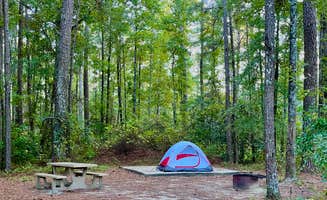Tent camping near Williston, South Carolina offers opportunities within the Savannah River watershed region, where elevations range from 100-400 feet above sea level. The area experiences hot, humid summers with temperatures regularly exceeding 90°F and mild winters with occasional freezing temperatures. Campers should plan for significant rainfall throughout the year, with monthly averages of 3-5 inches creating potentially muddy conditions at undeveloped sites.
What to do
Wildlife observation: Congaree National Park's Longleaf Campground serves as a base for firefly viewing during peak season. "We camped here to see the synchronous fireflies, and loved our stay! The group site was plenty big enough for all of the children, the hiking was excellent, and the fireflies were one of the most magical things I've ever seen!" notes Trina W.
Hiking trails: The park features well-maintained trails through diverse ecosystems. "Pristine, but organized trails near the Consgree river and Swamp. Lots of wildlife and ancient trees on the trails," explains J Terrell M. from Longleaf Campground.
Paddling: Waterways throughout the region offer paddling opportunities, though preparation is essential. Marissa H. shares her experience: "We took our 2 dogs hiking to the boardwalk trail which led back to the Visitor Center.. this was a decent 3+ mile hike our dogs were pooped! Overnight guests should be prepared to gather your own wood as none is sold on site."
What campers like
Solitude: Pine Hill Camp provides quiet camping with minimal crowds. Eric Z. reports, "Had it to ourselves for 3 days and the road going past was very quiet. Speaking of the road, it's a sandy dirt road with some soft spots so pay attention. Lovely quiet place to relax or work!"
Natural sounds: Camping areas often feature active wildlife, especially after dark. Kelly from Longleaf Campground notes, "The campground is next to a pond that gets rather loud at night. I never knew frogs/toads could be so loud. Easy walk to visitor center from campground."
Accessibility to supplies: Some camping areas offer convenience to necessities. David H. from Back to Nature Garden Center explains, "Small campground almost downtown but the dense woods make you feel like you're in the country. There's a family dollar next door if you forget anything."
What you should know
Site selection: At Longleaf Campground, proximity to parking varies significantly by site number. "Sites 1-3 are the easiest to get to. We were at site 7, it took about 250 steps from the parking lot to our site. All sites have lots of shade," advises Kelly.
Weather impacts: Low-lying areas experience frequent flooding during heavy rains. J P. from Clarks Hill warns, "It's lowlands so it floods easily in heavy rains...learned this the hard way!"
Bathroom facilities: Restroom quality varies significantly between locations. Veronica S. reports, "The vault toilet was disgusting, covered in splattered poop and very smelly. I sometimes drove to the visitor center to use the flush toilet and sink there."
Bug protection: Insect density can be extreme during warmer months. Joel R. cautions, "This is a small campground. It's National Park so there are no amenities. Walk in sites. Lots of bugs so come prepared."
Tips for camping with families
Gear transport: For walk-in sites, equipment transport requires planning. Jacinda S. from Longleaf Campground advises, "Definitely bring a wagon for packing your stuff in and prepare to be eaten alive by deer flies everywhere you go! The heat in June is also pretty bad, so having to go back and forth out to your vehicle to bring your stuff in and out is very difficult."
Campsite proximity: Families with young children should select sites closest to facilities. "If you don't want to walk far, get campsite #1. It's right next to the parking lot and closest to the bathrooms," recommends Jacinda S.
Water supplies: Potable water sources may require planning. "I never did figure out where the spigot was at the visitor center, but I didn't ask anyone (was going to fill up the morning we left, but they weren't open/staffed yet)," notes Veronica S. from Yamassee Indian Reservation.
Tips from RVers
Leveling requirements: Finding level spots can challenge larger vehicles. Eric Z. explains, "Not a lot of level spots around but we found a spot that worked for our 37' fifth wheel with some leveling. Were also able to position for decent solar exposure."
Signal strength: Connectivity varies significantly by location and carrier. "T-mobile was pretty much useless, AT&T provided a little bit of usable signal," reports Eric Z. from Pine Hill Camp.
Road conditions: Access roads to more remote sites can present challenges. Eric Z. warns, "Speaking of the road, it's a sandy dirt road with some soft spots so pay attention."


